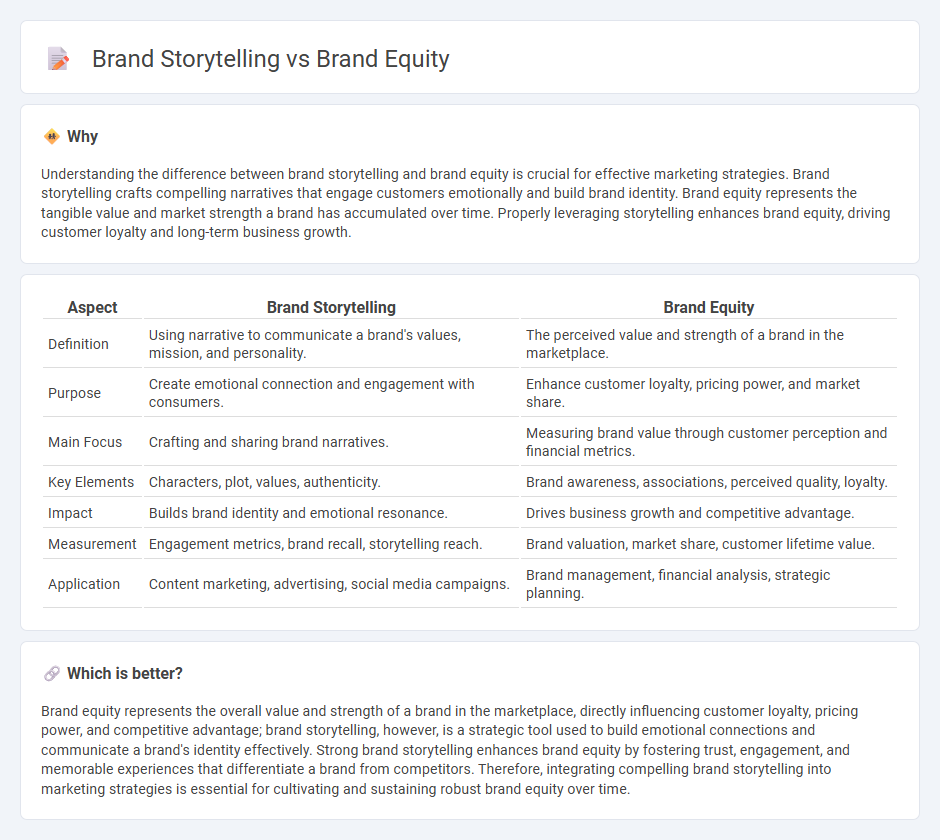
Brand storytelling shapes a company's identity by creating emotional connections through compelling narratives that reflect its values and mission. Brand equity represents the tangible value derived from consumer perceptions, loyalty, and market recognition built over time. Explore how integrating brand storytelling can significantly enhance your brand equity and market position.
Why it is important
Understanding the difference between brand storytelling and brand equity is crucial for effective marketing strategies. Brand storytelling crafts compelling narratives that engage customers emotionally and build brand identity. Brand equity represents the tangible value and market strength a brand has accumulated over time. Properly leveraging storytelling enhances brand equity, driving customer loyalty and long-term business growth.
Comparison Table
| Aspect | Brand Storytelling | Brand Equity |
|---|---|---|
| Definition | Using narrative to communicate a brand's values, mission, and personality. | The perceived value and strength of a brand in the marketplace. |
| Purpose | Create emotional connection and engagement with consumers. | Enhance customer loyalty, pricing power, and market share. |
| Main Focus | Crafting and sharing brand narratives. | Measuring brand value through customer perception and financial metrics. |
| Key Elements | Characters, plot, values, authenticity. | Brand awareness, associations, perceived quality, loyalty. |
| Impact | Builds brand identity and emotional resonance. | Drives business growth and competitive advantage. |
| Measurement | Engagement metrics, brand recall, storytelling reach. | Brand valuation, market share, customer lifetime value. |
| Application | Content marketing, advertising, social media campaigns. | Brand management, financial analysis, strategic planning. |
Which is better?
Brand equity represents the overall value and strength of a brand in the marketplace, directly influencing customer loyalty, pricing power, and competitive advantage; brand storytelling, however, is a strategic tool used to build emotional connections and communicate a brand's identity effectively. Strong brand storytelling enhances brand equity by fostering trust, engagement, and memorable experiences that differentiate a brand from competitors. Therefore, integrating compelling brand storytelling into marketing strategies is essential for cultivating and sustaining robust brand equity over time.
Connection
Brand storytelling enhances brand equity by creating emotional connections and memorable experiences that increase customer loyalty and perceived value. Compelling narratives communicate a brand's core values and differentiate it in competitive markets, fostering trust and recognition. Strong brand equity, built through consistent storytelling, drives higher market share and long-term profitability.
Key Terms
Perceived Value
Brand equity centers on the perceived value customers associate with a brand, influencing loyalty and pricing power through consistent quality and reputation. Brand storytelling enhances perceived value by crafting emotional connections and memorable narratives that differentiate the brand in competitive markets. Explore how integrating brand equity and storytelling strategies can elevate your brand's market presence effectively.
Emotional Connection
Brand equity is the value derived from consumer perception and loyalty toward a brand, which often hinges on a strong emotional connection established through consistent brand storytelling. Brand storytelling crafts memorable narratives that evoke feelings, foster trust, and deepen customer relationships, thereby enhancing brand equity. Explore how integrating storytelling can strengthen emotional bonds and boost your brand's long-term value.
Brand Narrative
Brand equity represents the value a brand holds in the consumer's mind, influenced heavily by perceptions of quality, loyalty, and recognition. Brand storytelling utilizes a compelling brand narrative to emotionally connect with audiences, enhancing brand identity and trust, thereby strengthening brand equity. Discover how mastering brand narrative can elevate your brand equity effectively.
Source and External Links
What Is Brand Equity? How To Build Brand Equity (2025) - Shopify - Brand equity is the market strength or value of a brand based on people's perceptions, influencing loyalty and pricing power, and it grows over time through quality customer experiences and marketing strategies.
Brand Equity Guide - DesignRush - Brand equity reflects the value of a brand shaped by consumer perceptions and can be built long-term by raising brand awareness, communicating brand meaning, inducing positive brand responses, and fostering customer relationships.
Brand Equity: What It Is, Why It Matters & How to Build It - Frontify - Brand equity is the value customers assign to a brand based on quality perception, leading to tangible benefits like higher pricing power and intangible benefits such as stronger loyalty and brand trust.
 dowidth.com
dowidth.com